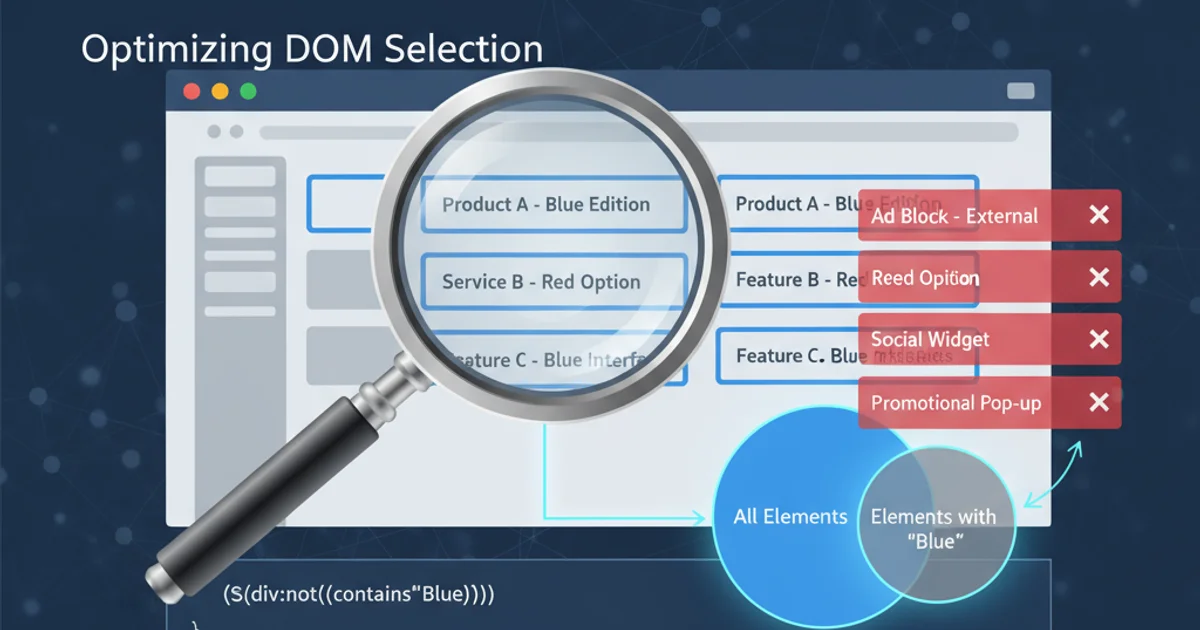jQuery "not contains" selector
Categories:
Mastering jQuery's ":not()" Selector for Element Exclusion

Learn how to effectively use jQuery's ":not()" pseudo-class selector to exclude specific elements from your selections, enhancing your DOM manipulation precision.
jQuery provides powerful tools for selecting and manipulating elements in the Document Object Model (DOM). While selecting elements that do match certain criteria is straightforward, there are many scenarios where you need to select elements that do not match a particular condition. This is where the ":not()" pseudo-class selector becomes invaluable. This article will guide you through understanding and effectively using jQuery's ":not()" selector to achieve precise element exclusion.
Understanding the ":not()" Selector
The ":not()" selector in jQuery (and CSS) allows you to filter out elements that match a specified selector from a given set. It acts as a negation, selecting every element that doesn't match the selector passed as its argument. This is particularly useful for creating more refined and targeted selections, avoiding the need for complex conditional logic in your JavaScript code.
// Select all <div> elements that do NOT have the class 'active'
$("div:not(.active)").css("background-color", "lightgray");
// Select all list items (<li>) that are NOT the first child
$("li:not(:first-child)").addClass("indent");
// Select all input fields that are NOT of type 'submit'
$("input:not([type='submit'])").val("Enter data");
Basic examples of using the ":not()" selector
flowchart TD
A[Start Selection] --> B{All Elements Matching Selector X}
B --> C{Apply ":not(Y)"}
C --> D{Filter Out Elements Matching Selector Y}
D --> E[Result: Elements Matching X BUT NOT Y]Conceptual flow of the ":not()" selector
Practical Applications and Advanced Usage
The ":not()" selector can be combined with other selectors for more complex filtering. You can chain multiple ":not()" selectors, or use it within other selectors to achieve highly specific results. Remember that ":not()" accepts any valid CSS selector as its argument, including classes, IDs, attributes, and other pseudo-classes.
<!-- HTML Structure -->
<ul id="myList">
<li class="item active">Item 1</li>
<li class="item">Item 2</li>
<li class="item special">Item 3</li>
<li class="item active">Item 4</li>
</ul>
<div class="container">
<p>Paragraph 1</p>
<p class="highlight">Paragraph 2</p>
<span>Span element</span>
</div>
Sample HTML structure for advanced examples
// Select all <li> elements within #myList that are NOT active AND NOT special
$("#myList li:not(.active):not(.special)").css("font-weight", "bold");
// Select all direct children of .container that are NOT <p> elements
$(".container > :not(p)").css("border", "1px solid blue");
// Select all elements that are NOT a <div> and do NOT have the class 'highlight'
$("*:not(div):not(.highlight)").css("color", "purple");
Advanced examples combining ":not()" with other selectors
.filter() or .not() (jQuery method) can be more readable and performant, especially for very dynamic or complex conditions.Performance Considerations and Alternatives
For simple exclusions, ":not()" is highly efficient as it leverages the browser's native CSS selector engine. However, for more complex filtering logic or when you already have a jQuery object, the .not() method can be a more flexible and sometimes more readable alternative. The .not() method operates on an existing jQuery collection, removing elements that match the provided selector or function.
// Using the .not() method to achieve the same result as ":not(.active)"
$("div").not(".active").css("background-color", "lightgray");
// Using .not() with a function for more complex logic
$("li").not(function() {
return $(this).text().includes("Item 1") || $(this).hasClass("special");
}).css("text-decoration", "underline");
Comparing ":not()" with the .not() jQuery method